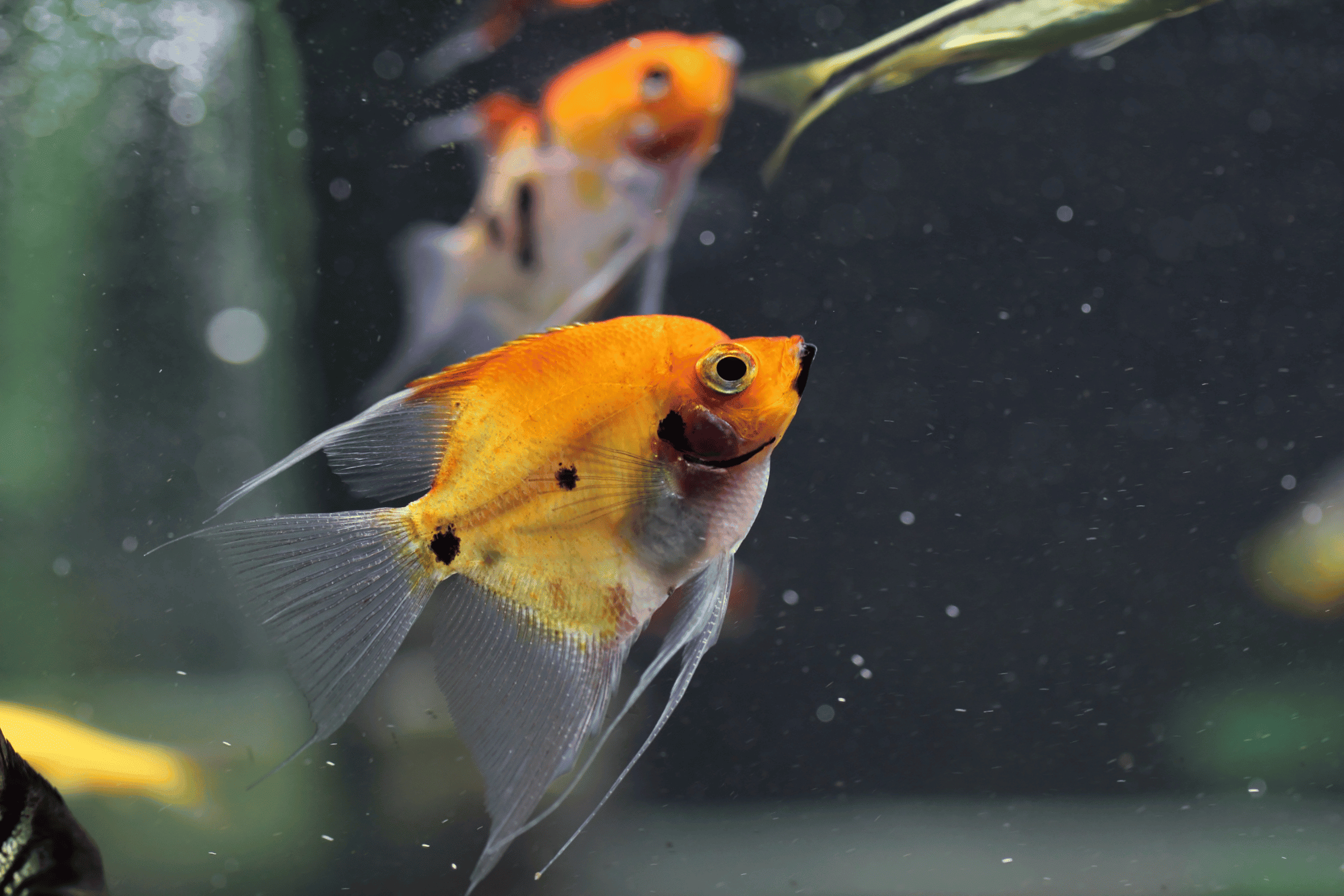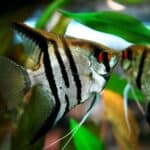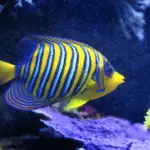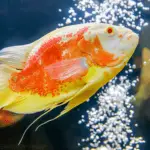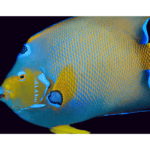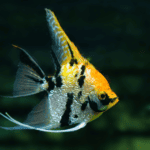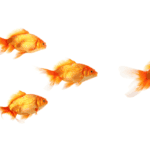Koi Angelfish, with their distinct orange and white coloration, have become a popular variety among freshwater aquarium enthusiasts. Known for bearing a striking resemblance to the Japanese Koi, they exhibit a captivating blend of color patterns that are the result of selective breeding. These fish are not only prized for their beauty but also for their unique personalities and graceful, serene swimming movements.
In the wild, Koi Angelfish originate from the Amazon Basin, where they inhabit slow-moving waters. However, the Koi patterns that we see today are products of careful selective breeding to mimic the appearance of Koi. Consequently, they are well-suited to life in well-maintained aquariums where their colors can develop fully. These angelfish require specific tank conditions to thrive, including ample space to accommodate their tall body shape and specific water parameters.
They are omnivorous by nature, demanding a balanced diet to maintain their vibrant coloration and health. Understanding the social dynamics and behaviors of Koi Angelfish is crucial for a harmonious tank. They tend to be somewhat territorial and are best kept with other fish that can coexist with them peacefully. For aspiring aquarists, it’s essential to research proper care requirements, including compatible tank mates.
Key Takeaways
- Koi Angelfish are selectively bred for their distinctive coloration and require specific care.
- Appropriate tank conditions and a balanced diet are essential for their health and vibrancy.
- Understanding their behavior is crucial for a peaceful and thriving aquarium community.
Origin and Habitat
Koi angelfish are a cultivated variety of freshwater angelfish, with roots tracing back to South America, particularly within the lush waterways of the Amazon River System.
Geographic Distribution
Originally, our Koi angelfish ancestors hail from extensive regions in the Amazon basin. This includes various water systems in countries such as Peru and Ecuador. Due to their popularity in the aquarium trade, they have been bred worldwide, but their native distribution remains within these South American territories.
- Countries: Peru, Ecuador
- Primary Habitat: Amazon River System
Natural Conditions
In their native habitat, Koi angelfish thrive in a wide range of subtle water conditions. The Amazon River System presents a diverse array of aquatic environments, where the water is typically warm, with temperatures usually between 76°F and 86°F (24°C to 30°C). The water is often soft to moderately hard and slightly acidic to neutral in pH, parameters that suit the health and growth of these fish.
- Temperature Range: 76°F – 86°F (24°C – 30°C)
- Water Hardness: Soft to moderately hard
- pH Level: Slightly acidic to neutral
Tapping into our extensive knowledge of these fish, we ensure their tank conditions mimic these natural settings for optimal health and longevity.
Physical Characteristics
In this section, we focus on the distinct physical aspects of Koi Angelfish which include their captivating color variations and their unique body shape and size. These characteristics have cemented their popularity among aquarists and freshwater fish enthusiasts.
Color Variations
Koi Angelfish are celebrated for their vibrant and diverse color patterns. The most commonly observed colors in these fish are:
- White: Often a base color for many Koi Angelfish.
- Orange: Ranges from light to bright shades, similar to the coloration of koi carp.
- Black: Provides sharp contrast and can appear as spots or stripes.
- Red: Less frequently observed but may present in some variations.
- Yellow: Typically a softer hue, adding to the fish’s warm color palette.
- Mottled Black: Irregular black patches creating a unique appearance.
Each Koi Angelfish has a distinct pattern of these colors, which contribute to its elegance and the intricate markings on its body.
Body Shape and Size
We recognize Koi Angelfish by their distinctive Pterophyllum Scalare lineage, which is a species of freshwater angelfish. They sport a:
- Body Shape: Laterally compressed, roughly triangular body enabling graceful movements.
- Size: Generally reaching about 6 inches in length.
- Fins: Long and flowing fins are a hallmark of their elegant appearance.
Koi Angelfish are not exceptionally large fish, but their fin extensions and vertical shape can make them seem larger than they are, and provide a stately presence in any freshwater aquarium.
Tank Requirements
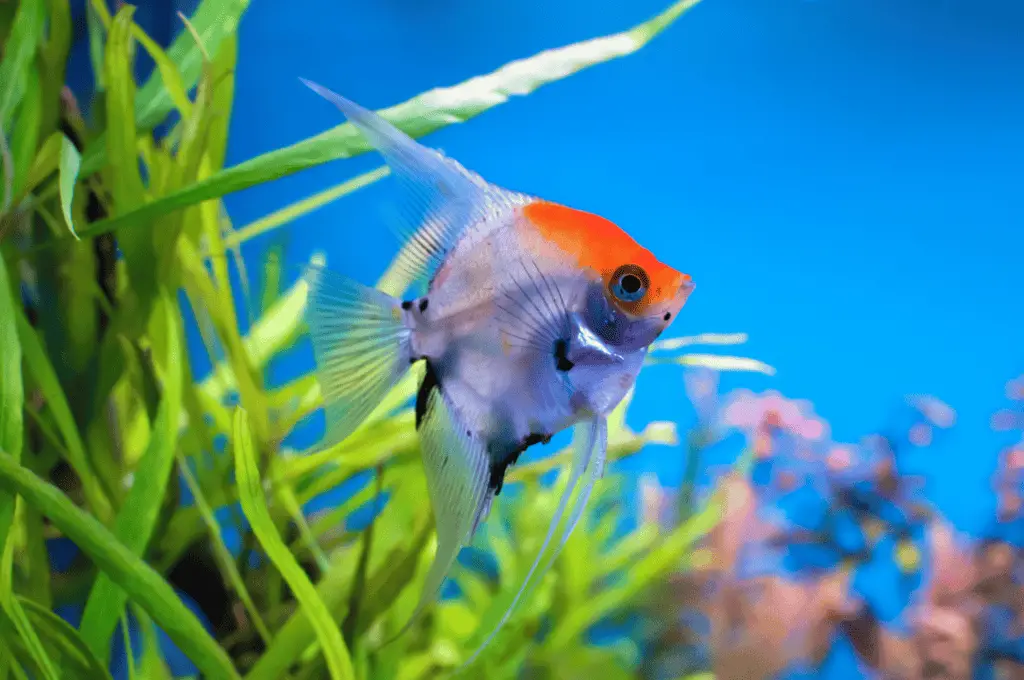
In setting up a tank for Koi Angelfish, we need to consider the specific habitat parameters these fish require to thrive, from the minimum tank size to the water conditions.
Aquarium Setup
The Minimum Tank Size for Koi Angelfish should be at least 20 gallons for a pair, but for a community, we recommend starting with a 55-gallon tank or larger. This allows sufficient space for swimming and territory establishment. The interior should mimic their natural environment with Substrate consisting of fine sand or smooth gravel, Driftwood for hiding spaces, and Live Plants such as Amazon swords and Java fern to provide a natural feel. Lighting should be moderate, mimicking a shaded tropical environment, whereas Filtration systems need to ensure clean water and a Moderate Water Flow to reflect their natural habitat without generating overly strong currents that can stress the fish.
Water Parameters
Our Koi Angelfish require:
- Water Temperature: Kept consistently between 76°F to 86°F, necessitating a reliable Heater.
- pH: Slightly acidic to neutral; ideally, between 6.8 and 7.8.
- Water Hardness: Ideally maintained between 3-8 dGH for softer conditions.
- Our aim is for Water Quality to remain high, with ammonia and nitrate levels close to zero, achievable through regular water changes. The presence of Vegetation and in particular Floating Plants can assist in maintaining water quality while also providing the fish with shelter.
By focusing on these elements, we can provide our Koi Angelfish with an environment conducive to good health and vibrant coloration.
Diet and Feeding
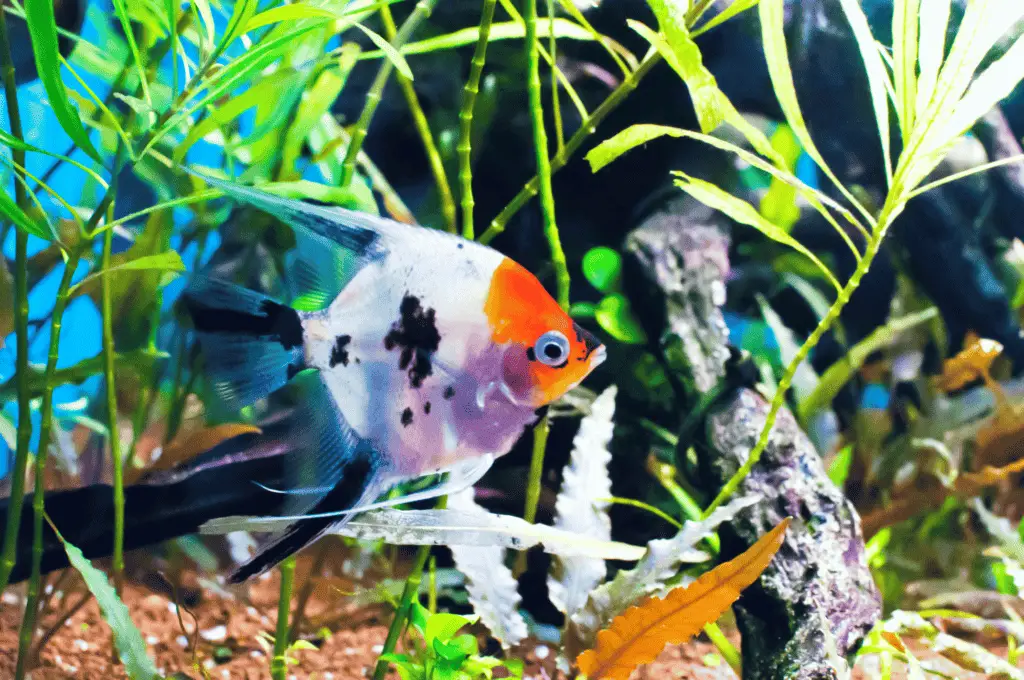
Our Koi Angelfish require a well-balanced diet to maintain optimal health. As omnivores, they benefit from a varied diet that includes both plant and animal matter. We ensure their nutritional needs are met by providing a mix of high-quality flake and pellet foods as the base of their diet.
Daily Routine:
- Morning and Evening: Feed small amounts that they can consume in three minutes to prevent overfeeding and ensure water quality.
Primary Diet:
- Flakes and Pellets: Formulated flakes and pellets should constitute the bulk of their diet. They are specifically crafted to provide the necessary nutrients and are convenient to use.
Supplemental Foods:
We occasionally supplement their diet with frozen or live foods to provide variety and additional nutrition. Our choices often include:
- Tubifex Worms: High in protein but should be given sparingly to avoid fat buildup.
- Blood Worms: A favorite among Koi Angelfish, these are ideal for occasional treats.
- Frozen Foods: We include high-quality frozen foods that are free from parasites and pathogens.
Pro Tip: Alternate between food types to provide a balanced diet and keep the angelfish engaged and interested in their food. This practice also minimizes the risk of nutritional deficiencies.
By adhering to these feeding practices, we promote the health and longevity of our Koi Angelfish, ensuring they thrive in their aquatic environment.
Behavior and Tank Mates
In the vibrant world of aquariums, understanding the social dynamics and ideal tank mates for Koi Angelfish is crucial for a harmonious environment.
Social Behavior
Koi Angelfish exhibit a distinctive social hierarchy, often forming monogamous pairs and demonstrating territorial behavior. In a community tank, we must monitor their interactions, as they can become dominating over smaller, more submissive fish. Their temperament is generally peaceful, but they can show signs of aggression during breeding or when competing for space with other dominant fish.
Compatible Species
To ensure compatibility in a community tank, it is imperative to choose tank mates that complement the behavior of Koi Angelfish. Ideal companions include other cichlids of similar size and temperament, as well as peaceful tropical fish. Here’s a brief list of compatible species:
- Rainbowfish: Active yet peaceful, they are excellent companions for angelfish.
- Corydoras: Bottom-dwellers that help keep the tank clean and rarely interfere with angelfish.
- Larger Tetras: Such as the Rummy-nose or Congo tetras, which are not small enough to be seen as prey.
When selecting tank mates, avoid overly aggressive species or very small fish that Koi Angelfish might mistake for food. By composing a well-considered community of compatible species, we promote a tranquil and stress-free environment for all inhabitants.
Frequently Asked Questions
In this section, we cover some of the most common inquiries about Koi Angelfish, providing straightforward information focused on care, compatibility, differences from other species, and purchase considerations.
What are the ideal tank conditions for Koi Angelfish?
The ideal tank for Koi Angelfish should have a capacity of at least 20 gallons and be fitted with a good filtration system to maintain clean water. A temperature of 76 to 86 degrees Fahrenheit and a pH level between 6.8 and 7.8 are essential for their wellbeing. We also recommend decorating the aquarium with plants and hiding spaces to mimic their natural environment.
How does the Koi Angelfish differ from other angelfish species?
Koi Angelfish are distinct primarily in their coloration, which resembles the Japanese Koi fish, with a mix of orange, white, and black patches. They differ from other angelfish species by this unique color pattern, which is not found in standard angelfish varieties.
What are suitable tank mates for Koi Angelfish?
Suitable tank mates include other peaceful fish of similar size, such as tetras, mollies, and dwarf gouramis. It is crucial to avoid placing them with fin-nipping species or overly aggressive fish that can cause stress to the Koi Angelfish.
What is the typical price range for Koi Angelfish?
Koi Angelfish can vary in price, typically ranging from $10 to $30 per fish depending on size, coloration, and source. Specialized or particularly striking specimens may fetch higher prices.
How do you maintain the health of Koi Angelfish in a freshwater aquarium?
To maintain their health, perform regular water changes, keep the water parameters stable, and provide a balanced diet consisting of high-quality flakes, pellets, and occasional live or frozen foods. Monitoring for signs of illness and addressing any issues promptly is also important for their health.
Is the Koi Angelfish known for being aggressive towards other fish?
Koi Angelfish can exhibit territorial behavior, especially during breeding. They are not typically known to be overly aggressive but may show dominance over smaller or more timid tank mates. It’s best to observe their behavior and ensure they have ample space and environmental enrichment to minimize aggression.
